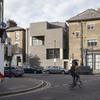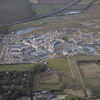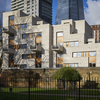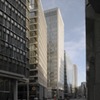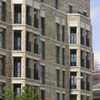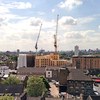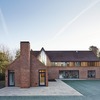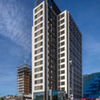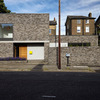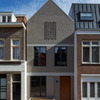Red House
Subscribe now to instantly view this image
Subscribe to the Architects’ Journal (AJ) for instant access to the AJ Buildings Library, an online database of nearly 2,000 exemplar buildings in photographs, plans, elevations and details.
Already a subscriber? Sign in
About a third of the ground-floor segment of the front façade steps out at an angle
Rory Gardiner Download Original
A house built on the site of a former garage brings a highly unusual contemporary end to a Victorian terrace in East Dulwich, London.
The ambition of this project was to design a contemporary dwelling that references and evolves the character and rhythm of the terrace while defying convention. Red House takes its name from the warm red brick, which is evident as a highlight brick in the existing terrace but is used here as the main building material to create impact.
Approaching the house, first impressions are dominated by its 150mm-thick cast-concrete façade up to first-floor height, which includes a relatively large, rounded arch above a ground-floor window, based on the arched doorways of the other houses in the terrace. Most of this portion of the elevation – the cast elements weigh about a tonne and were craned into position – has a three-dimensional decorative surface whose layers of geometric patterning are derived from typical Victorian entrance tiling.
The casting was produced using a silicone mould and a fine, thoroughly vibrated concrete mix. The smooth terracotta look accurately matches the colour of the bricks in the top half of the elevation.
About a third of the ground-floor segment of the front façade steps out at an angle and is faced with a rebuilt and extended yellow-brick wall, which follows the pavement line. The wall is topped with a slim concrete capping, which angles back and widens out as a canopy over the slightly dropped entrance threshold, and continues through the round-arched window to the right of it. A brick-coloured bin store forms a cornerpiece at the pavement edge. A small, partly glazed setback near the top of the front elevation allows natural light to wash down into the full-height reception volume.
The west side of the house is modelled with a double step; the front bedroom on the first floor sits at an angle across the otherwise orthogonal plan of the west and northern segments of the ground floor, whose roof and courtyard walls create a second, perimeter step.
The design achieves 130m2 of space on a small plot by lowering the ground floor, creating a split-level three-storey house in the space of the two-storeys of its neighbour. In plan the unconventional ground floor is then ‘pushed and pulled’, creating a series of visually connected spaces interspersed with courtyards, which bring daylight and greenery deep into the plan.
Data
- Begun: Oct 2015
- Completed: Apr 2017
- Floor area: 130m2
- Sector: Residential
- Total cost: £465,000
- CO2 Emissions: 15.05kg/m2/year
- Address: St Aidan's Road, London, SE22 0RP, United Kingdom
Professional Team 
- Architect: 31/44 Architects
- Client: Arrant Land
- Structural engineer: Elite Designers
- Approved building inspector : London Building Control
- Main contractor: Studio PL
- CAD software used: Vectorworks
















